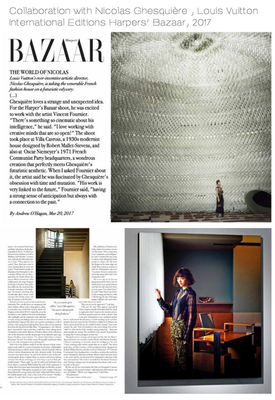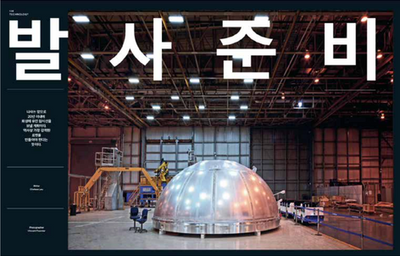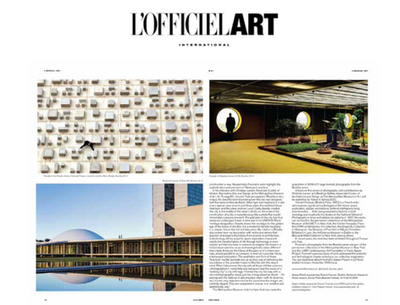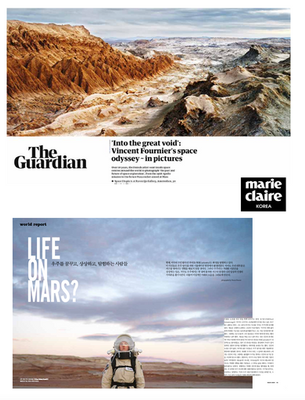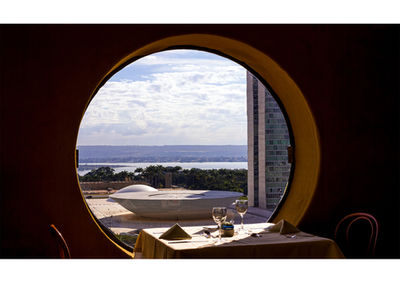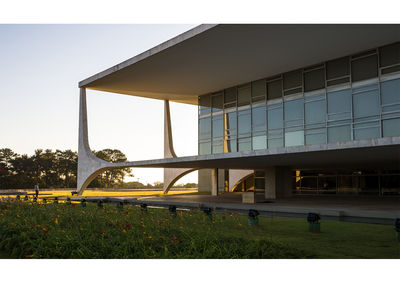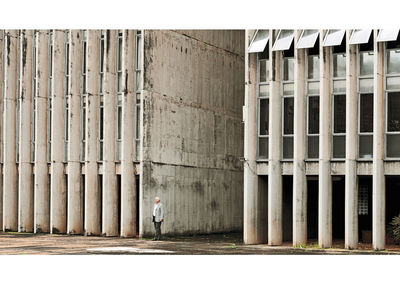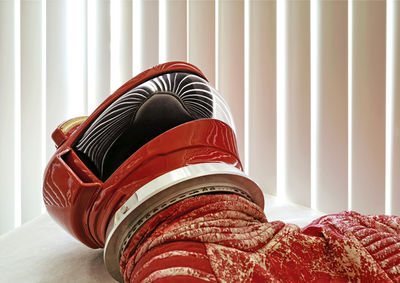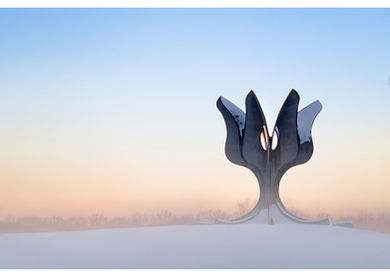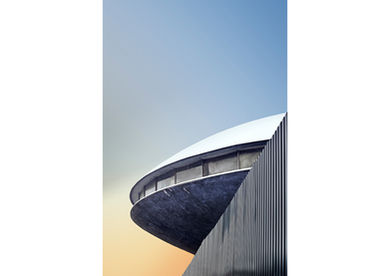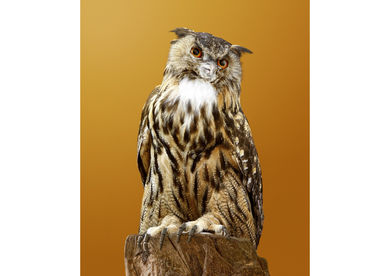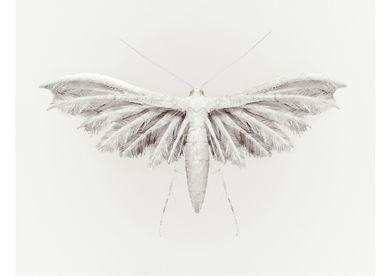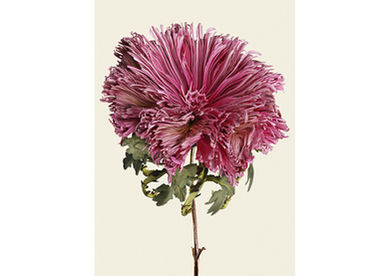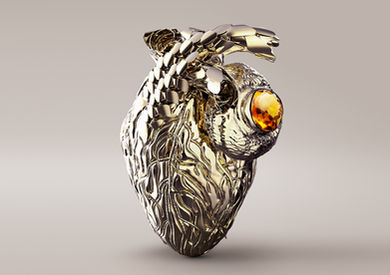
INTRODUCTION
Vincent Fournier, a French artist and photographer, delves into the realm of imagination and the future through his captiva- ting works.
His photographs capture the essence of space voyages, humanoid robots, utopian structures, and the transformative impact of technology on life.
By exploring futuristic narratives, Fournier uncovers fragments of the future within our present reality or even in the annals of history. His art takes viewers on a captivating journey through the most emblematic utopian visions of the 20th and 21st centuries, such as the exhilarating pursuit of space exploration, futuristic architectural marvels, and the dawn of artificial intelligence. Within these realms of imagination and possibility, memory functions as the White Queen in Alice in Wonderland explains it traverses not only the past but also reaches into the future. Fournier's art offers a unique perspective, where one can remember events before they unfold, opening doors to an extraordinary world of creativity and anticipation.
Vincent Fournier
Paris | France
BIOGRAPHY
Vincent Fournier, born in 1970 in Ouagadougou, is a distinguished French photographic artist He delves deep into the imaginings of the future — reflecting both past predictions and current visions for the days ahead. His work spans a range of topics, from the excitement of space exploration in the "Space Project" series, the fascination with humanoid robots in "The Man Machine," to utopian architecture in " Brasília" and "Kosmic Memories." He also ventures into the reinvention of the natural world with series like "Post Natural History," "Auctus animalis," and "Flora Incognita.”
Childhood memories, especially his visits to the Palais de la Découverte, infuse his work with a sense of scientific wonder. While he primarily expresses himself through photography, some of his projects also feature elements of 3D printing, animation, and installations.
In 2017, in collaboration with NASA, Vincent captured the essence of all the Space Centers across the USA.
By 2019, he was invited to the MET for a public showcase of his work during the "In Our Time" conference. His accolades include winning the Swiss Life 4 Hands Award in 2022. A year later, in 2023, the Musée de la Chasse et de la Nature spotlighted him with a monographic exhibition titled "Uchronie." This event also featured round-table discussions with influential authors such as Enki Bilal, Alain Damassio, Vinciane Despret, and others. Furthermore, between 2023 and 2024, the City of Science and Industry will be showcasing his "Space Utopia" series.
His creations have found homes in several esteemed permanent collections, including the Metropolitan Museum of Art in New York, Louis Vuitton foundation, Centre Pompidou in Paris, Mast Foundation in Bologna, and more.
His personal exhibitions have been showcased at prestigious institutions like the Centre Pompidou Metz, Triennale de Milan, and National Gallery of Victoria in Melbourne.
Beyond the art world, Vincent's collaborations span luxury and entertainment brands, from Louis Vuitton and Baccarat New York to working on "The Amazing Spider-man II" with Columbia Pictures. Currently, he is partnering with Cartier International on an exciting new project. [Learn More]
press

COLLECTIONS

Brasília: a Time Capsule
My fascination with Brasília stems from an intricate blend of enchantment and nostalgia, an attraction to the tales and portrayals of what the future once promised. Oscar Niemeyer's masterpiece, the Brazilian capital erected in just four years amidst desert expanses, encapsulates the 1960s' forward looking aspirations. The pilot plan, formulated in 1957 by urban planner Lucio Costa, emerged concurrently with the dawn of the space age, the time of Earth's first artificial satellite, Sputnik, and the golden era of the Space Age.
Brasília, resembling a UFO in an untouched wilderness, epitomizes the nostalgia and dream of a future trapped in the past. Its singularity is evident in its sheer scale an entire city. With its immaculate preservation, the pilot plan remains untouched, thanks to its status as a UNESCO World Heritage site.
A beacon of modernist design, Brasília stands as a testament to a utopian future, preserved as if in a time capsule.
As I navigated the city, I perceived it as a stage, with its residents cast in intricate roles. My explorations evoked a myriad of tales: JL Borges' "On Exactitude in Science" (1946), where a vast empire's map sprawls across its entire territory; D Buzzati's "The Tartar Steppe" (1940), narrating the chronicles of a man awaiting an event that never transpires; and P Weir's "The Truman Show" (1998), in which the protagonist resides within a constructed reality. One must also marvel at Brasília's awe-inspiring and profound beauty, where every element resonates in unison, marked by linearity, precision, minimalism, fluidity, grandeur, and musicality.
Selected works from the “Brasília” series have earned their place in the esteemed permanent collection of the Metropolitan Museum of Art in New York (further details available on the MET website) and within the Louis Vuitton (LVMH) collection in Paris.
Edition:
10 + 2 Artist proofs
Encompassing all formats.

Brasília through fournier's lens:
a dreamscape of modernist aspirations.
In the vast landscapes of Brazil, a unique gem emerges: Brasília. Envisioned and meticulously sculpted as a manifestation of future dreams, its creation was a bold statement of ambition and modernity. Vincent Fournier’s photography captures this essence masterfully, offering viewers a poignant glance into a future as it was dreamt from the vantage of the past.
Brasília is not merely a city; it is a symbol of Brazil’s rise, its aspiration to take its place confidently on the world stage. Oscar Niemeyer’s architectural designs characterized by flowing curves, bold forms, and audacious innovations meld seamlessly with Lúcio Costa’s urban planning genius. Together, they transformed a once barren plateau into a
living testament to progress and the human spirit.
Each frame by Fournier stands as a testimony to this grand vision. His photographs
delve deep, transcending mere aesthetics to capture the ethos of a city. These are more
than images; they are narratives that echo the boundless potential of humanity to
dream, to create, and to transform. His technique amplifies the drama of Brasília’s structures buildings that seem to emerge organically from the landscape, symbolizing Niemeyer’s architectural philosophy.
The expansiveness of the city’s vast spaces, marked by Fournier’s expert interplay of light and shadow, evokes feelings of awe, nostalgia, and contemplation. The stark
beauty, the contrast of the monumental with the minimal, prompts a profound reflection on time, human endeavor, and the nature of impermanence.
Enter Roberto Drummond’s narrative with « The Hinterland: A Story of Brasília. » His storytelling offers a literary counterpart to Fournier’s visual narrative. Drummond delves into the intimate lives of Brasília’s inhabitants their dreams, ambitions, triumphs, and challenges. The juxtaposition of the city’s carefully planned aesthetic with the organic, often chaotic, human narratives adds a rich layer of depth to our understanding of Brasília.
In our contemporary world, overflowing with visual stimuli and relentless pace, Fournier’s work offers a tranquil sanctuary. It is an invitation to journey into a dreamlike realm, where the boundaries between architecture and nature blur, crafting a harmonious symphony. His aesthetic, reminiscent of the surreal worlds painted by Jorge Luis Borges and Dino Buzzati, remains deeply anchored in the tangible, unyielding beauty of Brasília.
This exhibit, through the confluence of Fournier’s photographs and Drummond’s prose, strives to present Brasília in all its facets, a city of dreams, challenges, and endless possibilities.
Carolina Stubbe
- Art Hub -
![IMM #16 [dyptique1]](https://static.wixstatic.com/media/fdd3d3_0f0c061ea02248aeadddf591a4d3abd9~mv2.jpg/v1/fill/w_980,h_694,al_c,q_85,usm_0.66_1.00_0.01,enc_avif,quality_auto/fdd3d3_0f0c061ea02248aeadddf591a4d3abd9~mv2.jpg)
Space Project
Initiated in 2007 and continually evolving, the "Space Project" series is a chronicle of humanity's celestial journey, intertwining the past memories of the Apollo program and the progressive aspirations, such as NASA's SLS rocket aiming for Mars.
My images blend the objective lens of a historical documentarian with an artistry influenced by film and recollections from my formative years. Undeniably, my space allurement finds its roots in the 80s' futuristic depictions – a medley of movies, TV series, documentaries, and speculative fiction.
The photographic journey of the "Space Project" took me to the legendary bastions of space exploration: Russia's Star City, the Guiana Space Center, Baikonur Cosmodrome in Kazakhstan, the iconic landmarks of NASA, the Mars Desert Research Station (MDRS) in Utah, the austere Atacama Desert in Chile, and Svalbard Island's Arctic base. Additionally, I've ventured to modern private space entities, such as Virgin Galactic.
This odyssey captures astronauts in full gear, Apollo 8's mission control room, the 2011 final launch of the U.S. shuttle, and, as recently as 2019, the promising Artemis project at NASA’s Glenn Research Center – a symbol of our ambition to revisit the Moon and subsequently use it as a launchpad for Mars.
Each photograph in the series stands out for both its narrative depth and unadulterated visual grandeur. I emphasize the authenticity of these images: captured without any photomontage or filters.
This series has graced many renowned spaces, such as the MET New York, Mori Art Museum Tokyo, Centre 798 Art Zone Beijing, Art Science Museum Singapore, Shanghai Center of Photography (SCoP), FOMU Antwerp, Museum of Modern Art Bologna (MAMbo), Black Gold Museum, Le Centre de la Photographie de Genève, MUCEM Marseille, and the Rencontres d’Arles.
Edition:
10 + 2 Artist proofs, inclusive of all formats.

Kosmic Memories
The "Kosmic Memories" series unveils awe-inspiring architectural marvels, acting as monoliths of a potential future civilization, marking the horizon as symbols of an imagined elsewhere.
The birth of this science fiction-inspired realm between the late 1950s and early 1980s, especially within the satellite and non-aligned nations of the erstwhile USSR, is no stroke of chance. Initially, the allure of the cosmos deeply permeates the Russian psyche, evident from their embrace of Cosmism, the achievements of Tsiolkovsky, the launching of Sputnik, and Gagarin's historic space voyage. As the East edged closer to the West, artistic expressions began to liberate themselves from the chains of political dogmas.
While these architectural wonders serve varied purposes – from memorial to political to institutional – their designs echo a unified vision: envisioning a future steeped in the lore of science fiction. They stand as relics of an anticipated future, evoking images of flying saucers, interstellar stations, and an array of otherworldly geometric constructions. Predominantly forged in concrete and perched atop majestic landscapes, these mammoth structures radiate an alien energy, especially in the ethereal light of dawn or dusk. With their brutalist, futuristic, utopian, and esoteric allure, they stand as vigilant guardians of our yet-to- be-realized dreams of the morrow.
Edition:
10 + 2 Artist proofs
Encompassing all formats.

Post Natural History
Situated at the intriguing intersection of surrealism and technology, the "Post Natural History" bestiary emagines life's potential evolution beyond Darwin's understanding.
Through these photographs, viewers encounter an emerging collection of species. These include a diamond-studded peacock with a silver exoskeleton, a dragonfly with a glass abdomen and a luminescent air-quality sensor, and a beetle with a metallic antenna that integrates GPS technology.
This whimsical yet strangely familiar bestiary prompts reflection on our complex relationship with both nature and the ever-advancing technological world.
This evocative series has been showcased in various esteemed venues, including the Mori Art Museum in Tokyo. Notably, the Museum of Hunting and Nature in Paris procured several photographs and sculptures from the collection in 2023.
The series gained a cinematic spotlight through a collaboration with Columbia Pictures, featuring several "Post Natural History" images in the film "The Amazing Spider-man II."
Edition:
10 + 2 Artist proofs
Encompasing all formats
![PANTHERE NOSTALGIQUE [Panthera melancholia]_edited.jpg](https://static.wixstatic.com/media/fdd3d3_838d4a2536994f60af8bd8eaec2a59c6~mv2.jpg/v1/fill/w_980,h_602,al_c,q_85,usm_0.66_1.00_0.01,enc_avif,quality_auto/fdd3d3_838d4a2536994f60af8bd8eaec2a59c6~mv2.jpg)
Auctus Animalis
The tale of Auctus Animalis Island unfolds a captivating narrative where hybrid creatures undergo a metamorphosis, ascending to stardom. This evocative fable breathes life into a bestiary of augmented animals endowed with supernatural abilities.
Observers are beckoned to scrutinize closely, discerning the newfound attributes of each creature, now tethered between dual realms. Finding no sanctuary on Earth, the species of the Auctus Animalis Island take to the skies, morphing into constellations in a quest for equilibrium.
Positioned at the nexus of biology and surrealism, the audience is plunged into a mesmerizing realm, a delicate balance between tangible reality and ethereal virtuality. This realm not only challenges scientific truths but also embarks on a poetic exploration of life's evolution and transformation.
The collection has been awarded the Swiss Life Prize for 4 Hands.
Edition:
10 + 2 Artist proofs
Encompasing all formats.

The Man Machine
The "Man Machine" endeavor delves into the inevitable evolution of synthetic beings, be it robots or digital avatars, gradually integrating into the rhythm of our daily existence.
Backed by several pioneering humanoid robotics labs, I have crafted "futuristic narratives" that depict everyday moments with robots, seamlessly blending as if they were humans. The images bring to life realistic portrayals of routine situations: be it in the workplace, domestic settings, streets, or during recreational hours.
The settings insinuate a simultaneous sense of empathy towards these machines and an inherent detachment. This duality is reminiscent of Japanese roboticist Masahiro Mori's theory of the 'Uncanny Valley.' According to this, as an android approaches a near-human likeness, its minute discrepancies strike us as increasingly eerie.
My endeavor was to explore this oscillation of the viewer’s emotions, caught between the intrigue and estrangement towards these mechanical entities. With the collaborative spirit of Japanese labs, I tried to recreate everyday situations that were on the cusp of this emotional precipice.
Furthermore, I ventured into creating a short film that dances on this line of ambiguity, portraying robots inching closer to human emotions, while humans seem to evolve into more robotic entities.
This series has found its showcase in numerous esteemed museums, galleries, and institutions such as the Mori Art Museum Tokyo, Design Museum Gent, Festival Lianzhou, Photo Taiwan Design, Museum MAK Austrian Museum of Contemporary Art, Fondazione MAST, Hyundai Motor Studio Busan, Rencontres d’Arles, Gewerbemuseum Winterthur, V&A Dundee, and the Vitra Design Museum.
Edition:
10 + 2 Artist proofs
inclusive of all formats.

Situated at the intriguing intersection of surrealism and technology, the "Post Natural History" bestiary emagines life's potential evolution beyond Darwin's understanding.
Through these photographs, viewers encounter an emerging collection of species. These include a diamond-studded peacock with a silver exoskeleton, a dragonfly with a glass abdomen and a luminescent air-quality sensor, and a beetle with a metallic antenna that integrates GPS technology.
This whimsical yet strangely familiar bestiary prompts reflection on our complex relationship with both nature and the ever-advancing technological world.
Situated at the intriguing intersection of surrealism and technology, the "Post Natural History" bestiary emagines life's potential evolution beyond Darwin's understanding.
Through these photographs, viewers encounter an emerging collection of species. These include a diamond-studded peacock with a silver exoskeleton, a dragonfly with a glass abdomen and a luminescent air-quality sensor, and a beetle with a metallic antenna that integrates GPS technology.
This whimsical yet strangely familiar bestiary prompts reflection on our complex relationship with both nature and the ever-advancing technological world.
The Evolution Machine:
Flora Incognita
"Rose is a rose is a rose is a rose," mused Gertrude Stein in 1913. Her contemplation on the duality between reality and its echo – between reality and its echo—between nomenclature and essence—feels even more pertinent today. In an era where life unfurls its vibrant testament to constant metamorphosis, digital reincarnations in photography bestow upon us visions of nature – both reinvented and hallucinatory, each possibility sprawling infinitely.
From this mutating confluence of nature and its digital portrayal emerged the concept of the Evolution Machine – an imaginative device envisioning an alternate trajectory for life's evolution. This machine becomes a veritable vivarium, a space where virtual flowers burgeon in patterns uncharted yet plausible, echoing theories from speculative biology. It isn't just life but a pulsating vibrancy from another dimension, a kaleidoscopic whirl of metamorphoses where visuals weave their own tales.
Beyond simply portraying life on Earth, speculative growth narratives explore the frontiers of exobiology, musing on life's potential forms in extraterrestrial terrains.
In the "Flora Incognita" project, art melds with science fiction, its aesthetic resonating with the detailed artistry of Enlightenment-era encyclopedias, while simultaneously drawing inspiration from contemporary technological marvels. It presents a uchronic journey, running parallel to Charles Darwin's seminal theories on biological evolution.
Presented both as static and animated renditions, the project offers a herbarium-like collection of photographs and an installation where each "evolution" is depicted as a dynamic digital sculpture.
Edition:
10 + 2 Artist proofs
Encompasing all formats.
![CARMINA [Seraphica curiosis]](https://static.wixstatic.com/media/fdd3d3_2e50899c29984164902a93ec287e68f7~mv2.jpg/v1/fill/w_1400,h_991,al_c,q_85,enc_avif,quality_auto/fdd3d3_2e50899c29984164902a93ec287e68f7~mv2.jpg)
Flesh Flower
In the intricate dance of nature and human innovation, the Flesh Flowers
emerge as a beguiling testament to humanity's quest for merging boundaries. Drawing inspiration from the mythic Tartar lamb – a creature that was believed to straddle the realms of the animal and the vegetable – these flowers are both haunting and alluring.
The Flesh Flowers aren't just products of imagination; they meld legend with cutting- edge science. This artistic representation imagines the culmination of advanced tissue engineering research aimed at cultivating edible artificial flesh. It paints a portrait of a future where our dietary needs could be met by merging the botanical and the zoological in unprecedented ways.
These skeletal remains of the flowers stand as remnants of this artificial flesh. They symbolize the aftermath of humanity's audacious experiments and our relentless drive to mold the world to our whims.
However, there's an undeniable aesthetic allure to these creations. They are not merely scientific artifacts; they're pieces of art, evoking wonder, contemplation, and perhaps a touch of melancholy. As "precious vanities," they echo humanity's ever-present aspiration to manipulate life, but they also underscore the transient and fragile nature of existence.
Such masterpieces have not remained confined to the laboratory. Their artistic and conceptual profundity has garnered recognition and admiration worldwide. The Flesh Flowers have graced numerous renowned venues, ranging from the Musée des Arts Décoratifs in Paris to the Australian Centre for Photography in Sydney.

The Murmurs
In a world dominated by categorical divisions, the "Murmurs" stand as a defiant and enigmatic beacon, shattering the boundaries that compartmentalize existence. Originating from Alain Damasio's vivid imagination in his book 'Furtifs', these beings refuse to be pigeonholed. Not merely plant, mineral, or animal, they are an ephemeral blend of all, as if nature's very essence decided to weave itself into an ever-shifting tapestry.
The 'Murmurs' embody the fluidity of existence. Their name itself suggests whispers, hints of life that are just out of reach, eluding capture yet demanding attention. Moving at the velocity of sound, they represent the fleeting nature of moments, memories, and even life itself. They are the transient specters of our world, existing in the liminal spaces between the tangible and the intangible.
They are a testament to humanity's relentless drive to understand, to capture, and to showcase the wonders of existence, no matter how elusive.
For those who behold these sculptures, the experience is profound. They are not just viewing a piece of art but are engaging with a fragment of a universe that challenges their perceptions of life and categorization. The 'Murmurs' sculptures are a tribute to the limitless potential of imagination and the mysteries of the universe that continue to intrigue, enchant, and elude our grasp.

The Brain-Cloud
Vincent Fournier's 'Brain Cloud' offers a mesmerizing reflection on the nature of our memories in the digital age. Beyond its captivating physicality - a levitating 3D-printed cloud held in suspension by invisible forces - the artwork touches on deep existential questions of the contemporary world.
In today's digital era, the boundaries of what constitutes memory, both individual and collective, have dramatically shifted. Our photos, writings, personal details, and countless bytes of digital identity are stored in vast data centers, referred to as 'the cloud.' The name, evoking something intangible, ethereal, and vast, offers a stark contrast to the reality – sterile, buzzing warehouses of servers that store our lives' digital blueprints.
The 'Cloud Brain' brilliantly juxtaposes these themes of ethereality and tangibility. The cloud, traditionally a symbol of the fleeting and transient, is rendered concrete through 3D printing, yet remains suspended, giving it an almost supernatural aura. This duality challenges our perceptions of what's real and what's ephemeral, echoing the quandary of our digital memories. Are they less 'real' because they aren't present in a physical form?
Or are they even more tangible because they persist beyond the decay of physical mediums, housed within the vast, intangible expanse of the cloud?
Fournier's piece also delves into the debate of human memory versus digital storage. With the vast majority of our lives chronicled and saved in the digital domain, we have, in a sense, outsourced our memories. Does this make our human recollections less significant, or does it merely elevate them to a more abstract, philosophical plane?
The 'Brain-Cloud' stands as a testament to these modern dilemmas, beautifully encapsulated within the confines of a glass display. Floating between past and future, tangible and intangible, it invites viewers to contemplate the evolving nature of memory in an increasingly digital age. The piece is not merely a technological marvel; it delves into a profound philosophical exploration at the heart of modern existence.
The "Brain Cloud" entered the collection of the Centre Pompidou in Paris in July 2017. The piece is 3D printed and levitates on an electromagnetic field within a display cabinet, made of metal and glass. [67x20x18 inches]counterpart.

The Eternal Heart
[Infragilis Aurum Cor]
In the heartbeat, there's a cadence; a rhythm that underpins the cycle of life, marking both its inception and its conclusion.
The "Eternal Heart” epitomizes this rhythmic dance of life. Designed intricately with an amalgamation of gold and lead and accentuated by citrines, it mirrors the weight and dimension of an actual human heart. Its significance, however, goes beyond mere aesthetics. This bejeweled heart captures our profound and age-old yearning for immortality - a testament to our infinite aspirations that often grapple with the transience of life.
Such a portrayal finds parallels not just in modern-day biomedicine, which is constantly pushing the confines of life, but also in the rich tapestries of alchemical lore. The philosopher's stone, fabled to be the essence of eternal life, finds its echo in the Immortal Heart. It's as if the heart pulsates in the liminal space between yesteryears' mysticism and the futuristic promise where the human form, aided by technology and science, transcends mortality.
This exquisite piece is a product of an intricate collaboration with the Bermudes jewelry workshop based in Paris. Marrying traditional craftsmanship with cutting-edge techniques, the creation of the Eternal Heart necessitated over 200 meticulous hours of design effort. Its seamless aortas, devoid of any pins, stand testimony to this exquisite craftsmanship.
Adorning this first-of-its-kind edition are two breathtaking briolette citrines, weighing 39.90 carats and 40.16 carats respectively. Crafted with immaculate 18-carat gold, the heart's stature, at a height of 13.50 cm and weighing 500 grams, mirrors the intricacies of its human counterpart.
Below are some notable acquisitions of Vincent Fournier's works by museums and institutions:
- Musée de la Chasse et de la Nature in Paris, France, acquired photographs from the series "Post Natural History" and "Auctus animalis" for the permanent collection in 2022.
- Black Gold Museum in 2022.
- Centre Pompidou Paris acquired the "Cerveau-nuage" for the permanent collection. It is a 3D printing with a levitation system, acquired in 2017.
- The Metropolitan Museum of Art (MET) in New York acquired 5 large formats from the "Brasilia" series for the permanent collection in 2016.
- Dragonfly Collection (Domaine des Etangs / Primat) in Massignac acquired all 33 photographs from cycle II of the "Post Natural History" project and 2 sculptures from "Fleurs de chair" (cycle III of "Post Natural History") between 2014 and 2019.
- The St John of God Art Collection in Western Australia acquired a photograph from the "Post Natural History" series in 2016.
- LVMH Contemporary Art Foundation acquired 2 large formats from the "Brasilia" series in 2014.
- MAST Foundation in Bologna (Foto Industria) acquired 3 photographs from the series "Space Project" and "The Man Machine" in 2014.
- Baccarat Hotel Collection in New York, USA acquired 9 sculptures from the "Flesh Flowers" series in 2015.
- Science Gallery in Dublin acquired 3 photographs from the series "Post Natural History" in 2014.
Musée des Ursulines in Mâcon, France, acquired 5 photographs and 2 3D sculptures from the "Post Natural History" series in 2019.
The Bullukian Foundation in Lyon, France, acquired a photograph from the series "Space Project" in 2019.
Here is a selection of exhibitions featuring Vincent Fournier's work :
2023:
- Solo exhibition at Musée de la Chasse et de la Nature: "Uchronie" in Paris.
- Solo exhibition at Cité des sciences et de l’industrie: "Space Utopia" in Paris.
- Solo exhibition at Claire Gastaud Gallery: "Space Utopia" in Clermont-Ferrant.
- Solo exhibition at Praz-Delavallade: "Flora Incognita" in Paris.
- Solo exhibition at Spazio Nobile: "Specimen" in Brussels.
- Collective exhibition at PAD Paris: Presented by Spazio Nobile.
- Collective exhibition at Cité Musicale-Metz: "Prix Swiss Life à 4 mains, Auctus Animalis."
- Collective exhibition at Les Rencontres d’Arles: "Prix Swiss Life à 4 mains, Auctus Animalis."
- Collective exhibition at Shanghai Photofairs: Presented by Galerie Dumonteil.
- Collective exhibition at Center photographique Marseille: "Prix Swiss Life à 4 mains, Auctus Animalis."
2022:
- Solo exhibition: "Prix Swiss Life à 4 mains."
- Solo exhibition at Centre Pompidou Metz: "Art et Science Fiction, les portes du possible."
- Solo exhibition at Triennale de Milan: "Une introduction aux mystères."
- Solo exhibition at Centre Claude Cahun, Nantes: "Auctus Animalis, Prix Swiss Life à 4 mains."
- Solo exhibition at Kyotographie: "KG+, Post Natural History."
- Collective exhibition at Galerie 1839: Presented in Hong Kong.
- Collective exhibition at Galerie Au Cube: Presented in Mâcon.
- Collective exhibition at Galerie Clementine de la Ferroniere: Presented in Paris.
- Collective exhibition at Galerie Provost & Hacker: Presented in Lille.
2021:
- Solo exhibition at Musée des Beaux Arts des Ursulines: "Poste d’Histoire Naturelle" in Mâcon.
- Solo exhibition at Le Kiosque: "Space Utopia" in Nantes.
- Collective exhibition at MUCEM: "Civilisation" in Marseille, France.
- Collective exhibition at Shanghai Center of Photography (SCoP): "People and Places" in Shanghai.
- Collective exhibition at Galerie GONGBECH: "After the Rainbow" in South Korea.
2020:
- Solo exhibition at Le Kiosque: "Espace Utopie" in Nantes.
- Solo exhibition at The Cuturi Gallery: "Past Forward" in Singapore.
- Solo exhibition at La Galerie 1839: "Future Classic" in Hong Kong.
- Solo exhibition at Atelier Jespers: "Brasilia – Utopie moderniste" in Brussels, Belgium.
- Collective exhibition at Shanghai Center of Photography (SCoP): "People and Places" in Shanghai.
- Collective exhibition at Galerie GONGBECH: "After the Rainbow" in South Korea.
2019:
- Solo exhibition at Fondation Bullukian: "Space Utopia" in Lyon.
- Solo exhibition at The Ravestijn Gallery, Amsterdam: "Space Utopia" in the Netherlands.
- Solo exhibition at Domaine des Etangs: "Space Utopia" in France.
- Solo exhibition at Spazio Nobile: "Brasilia – A Time Capsule" in Brussels, Belgium.
- Collective exhibition at MET – The Metropolitan Museum of Art: Presentation of "Space Project" for the event "In Our Time: A Year of Architecture in a Day" in New York, USA.
- Collective exhibition at Musée d’Art Moderne et Contemporain de Saint-Etienne: "Le Cerveau-Nuage" as part of the "Design et merveilleux" exhibition.
- Collective exhibition at Musée d'art Mori: "The Future and Arts" in Tokyo, Japan.
- Collective exhibition at Centre d’art contemporain de Pékin: "Civilisation: The Way We Live Now" in Beijing, China.
- Collective exhibition at Ballarat International Foto Biennale: "To the Moon and back" in Australia.
- Collective exhibition at Royal Museums Greenwich: "Moonlight – 50 Years of Photographing the Moon" in London, UK, and Sweden.
- Collective exhibition at FOMU – the museum of photography in Antwerp: "Maan/Moon" in Antwerp, Belgium.
- Collective exhibition at Festival Photo Brussels: "Post Natural History" in Brussels, Belgium.
- Collective exhibition at Biennale d’architecture (UABB): "Space Project" in Shenzhen, China.
2018:
- Solo exhibition at Galerie [Perpitch&Bringand]: "Space Utopia" in Paris.
- Solo exhibition at Galerie du Château d’Eau: "Past Forward" in Toulouse.
- Solo exhibition at Centre d’Art Sacré: "Space Utopia" as part of Transphotographique at Galerie Provost-Hacker in Lille.
- Collective exhibition at Taiwan Design Museum: "Future Cross Boundaries" in Taipei, Taiwan.
- Collective exhibition at Festival Lianzhou Photo: "Man Machine" in Lianzhou, China.
2017:
- Solo exhibition at Museo d’Arte Moderna di Bologna: "Past Forward" as part of Foto Industria at Fondazione MAST in Bologna, Italy.
- Solo exhibition at Australian Center for Photography (ACP): "Post Natural History" in Sydney, Australia.
- Collective exhibition at Centre Pompidou: "Imprimer le Monde" featuring the artwork "Le Cerveau-Nuage" in Paris, France.
- Collective exhibition at Vitra Design Museum: "Hello, Robot" in Weil am Rhein, Germany.
- Collective exhibition at Musée ArtScience: "L’univers et l’art" in Singapore.
- Collective exhibition at MAK, Austrian Museum of Applied Arts/Contemporary Art: "Hello, Robot" in Vienna, Austria.
- Collective exhibition at Maison des Arts de Créteil: "Space Oddity" as part of the Month of Photography in Paris.
- Collective exhibition at Salon du PAD Paris: Presented by galerie [Perpitch&Bringand] in France.
2016:
- Solo exhibition at Perth Centre for Photography: "Post Natural History" in Perth, Australia.
- Solo exhibition at Alliance Française: "Post Natural History" in Melbourne, Australia.
- Solo exhibition at Galerie Spazio Nobile: "Post Natural History" in Brussels, Belgium.
- Solo exhibition at New Square Gallery: "Past Forward" in Lille, France.
- Collective exhibition at Mori Art Museum: "The Universe and Art" in Tokyo, Japan.
- Collective exhibition at Salon du PAD Paris: Presented by galerie [Perpitch&Bringand] in France.
2015:
- Solo exhibition at La Galerie: "Post Natural History" in Hong Kong.
- Participation in Foire Amsterdam Art Fair: Presented by The Ravestijn Gallery in Amsterdam, Netherlands.
- Participation in Art Central Fair in Hong Kong.
2014:
- Solo exhibition at Espace Quai 1: "Post Natural History" in Vevey, Switzerland.
- Installation at Le Bon Marché: "Brasilia" in Paris, France.
- Collective exhibition at Fondation EDF/Electra: "Alive" in Paris, France.
- Collective exhibition at Musée des Arts Décoratifs de la ville de Paris: "Salon AD" in Paris, France.
- Collective exhibition at Centre 798 Art Zone / Thinking Hands: "Space Project" in Beijing, China.
- Collective exhibition at Z33 House for Contemporary Art: "Space Odyssey 2.0" in Hasselt, Belgium.
- Collective exhibition at Biennale Internationale de la Photographie et des Arts Visuels: Liège, Belgium.
- Participation in Festival Getxophoto in Bilbao, Spain.
- Participation in Festival Kyotographie in Kyoto, Japan.
- Participation in Festival Cortona On the Move in Italy.
2013:
- Collective exhibition at Centre d’Art Contemporain de Pontmain: "La science à l’œuvre" in France.
- Collective exhibition at Science Museum/Fabrica: "The Man Machine" in Moscow, Russia.
- Collective exhibition at Le Centre de la Photographie de Genève: "False Fake" in Switzerland.
- Collective exhibition at NAI/Institut d’Architecture des Pays-Bas: "Post Natural History: Bio Design" in Rotterdam, Netherlands.
- Collective exhibition at Science Gallery: "Grow Your Own" in Dublin, Ireland.
- Participation in Salon Show Off in Paris, France.
2012:
- Solo exhibition at Les Rencontres d’Arles: "Space Project & The Man Machine" in Arles, France.
- Solo exhibition at Joye Gallery: Solo exhibition in Brussels, Belgium.
This selection showcases Vincent Fournier's exhibitions and highlights his artistic journey since 2012.











